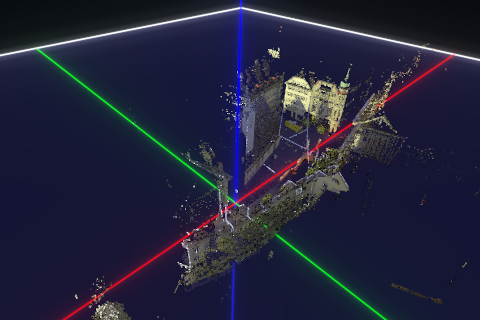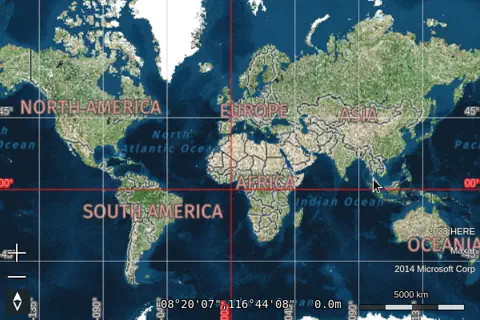2023.1.07
ImprovementLuciadRIA
RIA-4716
OGC3DTilesModel from the constructor options.
Bug fixLuciadRIA
RIA-4710
Bug fixLuciadRIA
RIA-4711
Bug fixLuciadRIA
RIA-4708
Bug fixLuciadRIA
RIA-4704
2023.1
2023.1.06
Bug fixLuciadRIA
RIA-4692
ADAPTIVE_WORLD_SIZE style is not applied correctly when the map is resized.
Bug fixLuciadRIA
RIA-4702
metallicFactor and roughnessFactor in the material definition of MeshStyle being incorrectly taken
in account when using physically based rendering.
Bug fixLuciadRIA
RIA-4685
Bug fixLuciadRIA
RIA-4690
ReferenceProvider, it didn't always return a
reference with correct axes.
Bug fixLuciadRIA
RIA-4686
minimum and maximum
fields of the properties of OGC3DTilesModelDescriptor.
Bug fixLuciadRIA
RIA-4320
GeoJsonCodec now removes this duplicate point when decoding the GeoJSON polygon to
a LuciadRIA geometry. Before this fix the start and the end point would be present twice in a LuciadRIA geometry,
which could yield unexpected behavior when editing a polygon.
2023.1.05
ImprovementLuciadRIA
RIA-4669
Bug fixLuciadRIA
RIA-4670
Bug fixLuciadRIA
RIA-4678
2023.1.04
Bug fixLuciadRIA
RIA-4668
Bounds shape with a CreateController.
Bug fixLuciadRIA
RIA-4661
Bug fixLuciadRIA
RIA-4655
Bug fixLuciadRIA
RIA-4653
ReferenceProvider is now more flexible in
accepting parameter names for the projection center.
Bug fixLuciadRIA
RIA-4647
GeoJsonCodec now removes this duplicate point when decoding the GeoJSON polygon to
a LuciadRIA geometry. Before this fix the start and the end point would be present twice in a LuciadRIA geometry,
which could yield unexpected behavior when editing a polygon.
Bug fixLuciadRIA
RIA-4654
map.layerTree.whenReady()
promise might be thrown when the map is created in a tab that remains in the background
for 5 minutes.
2023.1.03
ImprovementLuciadRIA
RIA-4361
ImprovementLuciadRIA
RIA-4627
Bug fixLuciadRIA
RIA-4642
WMSCapabilitiesLayer.getBounds() and
WMTSCapabilitiesLayer.getBounds() can return null. This was not reflected in the
TypeScript API and is now corrected.
Bug fixLuciadRIA
RIA-4641
__LUCIAD_ROOT__/license when
the global variable __LUCIAD_ROOT__ wasn't defined.
Bug fixLuciadRIA
RIA-4626
WMSTileSetModel or WMSImageModel
using createFromURL() or createFromCapabilities() would create a
model with a CRS:84 model even if the server's capabilities did not support that coordinate reference. The
factory methods will now attempt to create a model with a supported coordinate reference.
Bug fixLuciadRIA
RIA-4637
FeatureLayer.workingSet).
Bug fixLuciadRIA
RIA-4543
svg tag,
caused a crash.
Bug fixLuciadRIA
RIA-4544
Bug fixLuciadRIA
RIA-4643
Map where you
could not move the shape.
Bug fixLuciadRIA
RIA-4636
- you pan away from the selected feature over a long distance
- a
FeatureLayer.transformeris reset and the original features put into the model had no IDs - a
FeatureLayer.filteris reset and the original features put into the model had no IDs
2023.1.02
ImprovementDefense Symbology
RIA-4519
MilitarySymbologyPainter to get the actual bounds of a military symbol,
that can then be used for fitting on that symbol.
Note that regular fitting on the shape of a military symbol will not always give you the desired result.
The reason for this is that the symbol shape mostly only contains the anchor points for the symbol,
which are then used to calculate a very different final shape to be drawn.
Bug fixLuciadRIA
RIA-4463
DOUBLE_LEFT_HALF and DOUBLE_RIGHT_HALF were twice
the intended size or were omitted partially instead of fully when there is a lack of space.
Bug fixLuciadRIA
RIA-4585
Fixed a bug where draping on meshes could produce blurry results if the meshes was not set as part of terrain.
Bug fixLuciadRIA
RIA-4606
Topology that in certain situations could influence outputs
of the constructive geometry operations.
Bug fixLuciadRIA
RIA-4601
WebGLMap would throw errors when its border is larger than
its encompassing html node.
Bug fixLuciadRIA
RIA-4598
GeoBuffer.contains2DPoint could throw an error when the buffer's base shape
was a Polyline and its end cap was defined set to EndCapStyle.CAP_BUTT.
Bug fixLuciadRIA
RIA-4609
Bug fixLuciadRIA
RIA-3852
CircularArc and CircularArcBy3Points
are now more accurate. Before, the bounds were too small in some cases.
Bug fixDefense Symbology
RIA-4518
MilitarySymbologyPainter#createSymbolImage)
did no longer work as expected (no preview or wrongly scaled/bounded preview).
Bug fixDefense Symbology
RIA-4554
Upgrade considerationLuciadRIA
RIA-4610
boost library has been updated to version 1.83.0.
2023.1.01
ImprovementLuciadRIA
RIA-4587
Bug fixLuciadRIA
RIA-4501
Bug fixLuciadRIA
RIA-4551
LabelStyle.priority is now deterministic,
which improves label stability when updating positions of individual features. Before the fix, small position
changes of a feature resulted in showing different labels in the vicinity of the modified feature.
Bug fixLuciadRIA
RIA-4576
Bug fixLuciadRIA
RIA-4574
Bug fixLuciadRIA
RIA-4588
OGC3DTilesModel.
It did not properly implement AttributedTileSet.
2023.1
New featureLuciadRIA
HSPC Pack files are now supported on HSPCTilesModel and
TileSet3DLayer.
New featureLuciadRIA
3D Cartesian references, for example the "LUCIAD:XYZ" reference or those created with
ReferenceProvider.createCartesianReference,
can now be used as the world reference on a WebGLMap. This allows you to visualize
non-georeferenced data on a 3D WebGLMap.

The use of a WebGLMap with a 3D Cartesian reference is demonstrated in the 3D icon sample,
which now displays a separate panel when you select an icon. The panel uses a 3D Cartesian world reference.
A WebGLMap with a 3D Cartesian reference has certain limitations and conventions to take into account.
For more information, please see the article on Cartesian views.
New featureLuciadRIA
@luciad/ria-sample-common package (which we don't recommend since we
don't guarantee backwards-compatibility for our samples), you will need to change your imports.
New featureLuciadRIA
New featureLuciadRIA

New featureLuciadRIA
TileSet3DLayer.selectedOcclusionStyle and TileSet3DLayer.selectedOutlineStyle.
For an example of how to use these new styles, see
Using occlusion and outline styles for selected features.
New featureLuciadRIA
map.effects.fog and FogEffect for more details.
See also the article Configuring WebGL Map effects.
ImprovementLuciadRIA
You can now set the property facetCulling on a Icon3DStyle.
The facetCulling property defines the polygons that are not visible to the camera and will be discarded.
ImprovementLuciadRIA
TileSetAttribution.getLayerAttributions and the corresponding
"LayerAttributionsChanged" event to match attribution strings and logos to their respective
layers.
ImprovementLuciadRIA
RIA-4555
The precision of WKT references that use an ellipsoidal version of the Lambert azimuthal equal area projection has been improved. This affects the following EPSG codes:
- 3035
- 3571 to 3576
- 5633, 5635, 5636, 5638
- 6931, 6932
- 9039
- 9947
ImprovementLuciadRIA
BASED_ON_DATA as a new FacetCullingType when you are styling mesh data
for a TileSet3DLayer. You can use it if you
are unsure about the face culling type or if you are using a 3D Tiles set that uses GLTF version 2, or if you are mixing
double-sided and non-double-sided material.
ImprovementLuciadRIA
RIA-4487
LayerTreeNode now emits events named "VisibilityInTreeChanged". The callback on this event
hook gets called when the visibleInTree of the layer tree node changes.
This allows you to react on a layer becoming visible or invisible on a LuciadRIA map.
ImprovementLuciadRIA
RIA-4477
GeoJsonCodec now fully supports features with the null geometry, both when decoding and encoding.
ImprovementLuciadRIA
ImprovementLuciadRIA
RIA-4379
ImprovementLuciadRIA
WebLGMap will now show a watermark.
ImprovementLuciadRIA
RIA-1546
KMLPainter API is now exposed, so that you can extend it to implement a custom styling of
KMLPlacemarkFeature objects. Also, KMLPainter exposes methods
to obtain LuciadRIA style objects that correspond to
the KML style embedded in placemark features. For more information, refer to KMLPainter.
ImprovementLuciadRIA
RIA-3293
FeatureId type alias.
ImprovementLuciadRIA
RasterStyle: properties to change the contrast and brightness of a
RasterLayer have been added. And it is now also possible to configure a modulation color.
ImprovementPanoramic
RIA-4362
WFSFeatureStore.bounds exposes now data bounds from WFS capabilities.
Bug fixLuciadRIA
RIA-4573
MapNavigator.pan. It didn't pan to the right location when passing
in a world or model point with a height above ellipsoid.
Bug fixLuciadRIA
RIA-3969
ShapeStyle.zOrder was not applied correctly when used in combination with
ShapeStyle.occlusionMode.
Bug fixLuciadRIA
Bug fixLuciadRIA
RIA-4530
ClusterShapeProvider. Before, in such a situation,
3D points were always reduced to 2D points. Please note that the default cluster shape provider
still returns anchor points with the Z-coordinate equals to 0.
Bug fixLuciadRIA
RIA-4522, RIA-4461
DOUBLE_LEFT_HALF and
DOUBLE_RIGHT_HALF were twice the intended size or were omitted partially instead of fully
when there is a lack of space.
Upgrade considerationLuciadRIA
myVRArchive library to support Hexagon Smart Point Cloud (HSPC)
Pack files. This new dependency requires no code changes.
Upgrade considerationLuciadRIA
WebGLMap.globeColor
has new behaviour.
The globeColor can now be set to null to avoid painting a globe
entirely.
This also disables 2D vector and raster painting. Only data that does not need to be draped will be rendered on
the map.
On top of that, you can now set the alpha value of your globeColor to 0, which will render
a
fully transparent globe in the absence of raster layers.
The fully transparent globe still allows you to drape 2D shapes and images on top of it.
Setting a globeColor with an alpha values between 0 (exclusive) and 1 (inclusive) will
render
the globe with a fully opaque color.
Upgrade considerationLuciadRIA
RIA-3811
Icon3DStyle: The axis system for rendering 3D icons has been changed. The Y-axis now points
to the north, the X-axis to the east and the Z-axis upwards.
When loading glTF files they are now also automatically converted from their Y-up axis system to the LuciadRIA axis system, as a result you will in most cases no longer need to apply rotations to have your model oriented correctly.
For compatibility reasons Icon3DStyle.legacyAxis was added. Setting this property to true
restores the behavior as it was. In the LuciadRIA 2023.1 release this property defaults to true, so you do not
need to update existing code. From LuciadRIA 2024.0 onwards the default will be set to false, it is recommended
to already adapt your code for the changes in the axis system.
Upgrade considerationLuciadRIA
libtiff version 4.5.1.
Upgrade considerationLuciadRIA
Icon3DStyle now
operates clockwise instead of counter-clockwise.
These changes were made to improve consistency with other functionality where the Y-axis of the cartesian reference
serves as the north direction (e.g. LookAt, IconStyle.heading, etc.).
Upgrade considerationLuciadRIA
RIA-4477
GeoJsonCodec.decodeGeometry and GeoJsonCodec.decodeGeometryObject
can now return null. This is a consequence of the enhancement to support features
with the null geometry by GeoJsonCodec.
Upgrade considerationLuciadRIA
Upgrade considerationLuciadRIA
boost library has been updated to version 1.83.0.
Upgrade considerationLuciadRIA
RIA-1692
The versions property in
WFSFeatureStoreConstructorOptions,
WFSCapabilitiesFromUrlOptions, and
WFSFeatureStoreCreateOptions are not anymore of the "string" type but
WFSVersion enumerations.
The allowedVersions property passed to
WFSCapabilities.fromURL is not anymore of the "string" but
WFSVersion enumerations.
The WMS version property in
WMSImageModelConstructorOptions, and
WMSTileSetModelConstructorOptions is not anymore of the "string" type.
Versions are now represented as WMSVersion enumerations.
The allowedVersions property passed to
WMSCapabilities.fromURL,
WMTSCapabilities.fromURL is not anymore of the "string" but
WMSVersion enumerations.
WFSFeatureStore from capabilities with a specific WFS version:
createFromCapabilities(capabilities, featureTypeName, { versions: ["2.0.0"] });
createFromCapabilities(capabilities, featureTypeName, { versions: [WFSVersion.V200] });
Upgrade considerationLuciadRIA
RIA-4433
FeatureModel.get. The return value can also be
undefined, which is the case when no feature with the given id exists in the model.